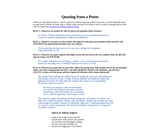
A collection of persuasive essay worksheets, rubrics, and activities for varying levels.
- Subject:
- English Language Arts
- Material Type:
- Activity/Lab
- Provider:
- E Reading Worksheets
- Author:
- E Reading Worksheets
- Date Added:
- 02/26/2019

A collection of persuasive essay worksheets, rubrics, and activities for varying levels.

A collection of persuasive essay and speech topics for varying levels.

This resource includes sample topics for position papers as well as criteria for evaluation.

Students learn how to approach an initial reading of a poem. Using Shakespeare's Sonnet 130 as a starting point, students work through comprehension and analysis of structure and tone to move towards creating a thesis about the poem.

Speech writing is a rhetorical art and provides the content for these scaffolded lessons that support the increased cognitive rigor of literacy standards with presidential writings.

This activity can be adapted among grade levels, and involves students practicing describing objects by their properties.

This resource examines five useful prewriting strategies with examples of how to use them.

This resource discusses different prewriting and writing exercises.

In this lesson, students create a persuasive flyer to sway the opinion of the class on a controversial issue.

This lesson is designed to assist students through multiple sessions with identifying relevant propaganda techniques in literature, discussing persuasive elements found in print and non-print media and composing a persuasive essay. Lesson is appropriate for use with a provided list of novels to include Bradbury's Fahrenheit 451.

Students are guided through how to use quotes and quotation marks when writing about a poem. A specific example is given using the poem "Fifteen" by William Stafford. Students are then given guided questions and directions to practice the technique using Sylvia Plath's "Mirror" as a sample text. The students are directed to use specficic textual evidence from the poem to discuss the poem's meaning and figurative language.

This resource provides an informational reading and short writing activity. Students are tasked with responding to the passage by utilizing textual evidence.

The Committee of Public Safety's assumption of political power and rule between 1793 and 1794 marked what was arguably the most radical phase of the French Revolution. The Committee justified its excesses as necessary to protect against domestic and foreign counter-revolutionaries. In this lesson, students question the motives of the Committee through analyzing excerpts from the "Decree Against Profiteers" and "Law of Suspects."

Students read an article (which is included in this link) that asserts that all stories across time and medium can be put into one of seven models. Students will then search the newspapers and their own knowledge of books, film, television,etc. to compare and contrast with the nonfiction pieces as well as the article's theory about thematic connections. Any respected newspaper will suffice for this lesson.

Students consider a novel approach to conservation biology in which the goal is not to preserve a particular organism or even a habitat, but to actively promote the reestablishment of the late Pleistocent environment. Once introduced to the topic, students will take on the role of a conservation biology advisory group and conduct research to gather more information and assess the overall impact of re-wilding, including environmental, social, and economic concerns. At the conclusion of the lesson, students will present their recommendation to reintroduce the organism or not.

In this lesson, students create video review of film versions of Shakespeare's classic tragedy, Romeo and Juliet. Working in groups, students view one of a list of modern interpretations of the play, then plan, record, and publish a video review of their chosen film.

This lesson is designed to apply Common Core State Standards and facilitate a comparison of informational texts and primary source material from the Scottsboro Boys trials of the 1931 and 1933, and the fictional trial in Harper Lee's novel, To Kill A Mockingbird (1960).

In this lesson, students examine historical and current examples of separation of church and state. A set of discussion questions is provided. In an associated activity, students discuss laws and governments acts concerning church and state. Then, students will write a persuasive letter to one of the historical figures mentioned in the reading who differs with their position on separating church and state.

This resource provides a lesson designed to provide students with a guide for reading and interpreting the text, Harrison Bergeron. Students will spend time analyzing the author's use of irony. The lesson provides a set of guided reading questions as well as a culminating writing activity.

This lesson plan is designed to introduce students to the rhythms of poetry. The lesson focuses on two poetic forms: the Ballad stanza and the Blues stanza. Lesson includes notations to incorporate poetry analysis and recitation. The lesson also involves practice skills to recognize and understand poetic structures such as: iambs, measures and rhythm. It includes a link to applicable music files.